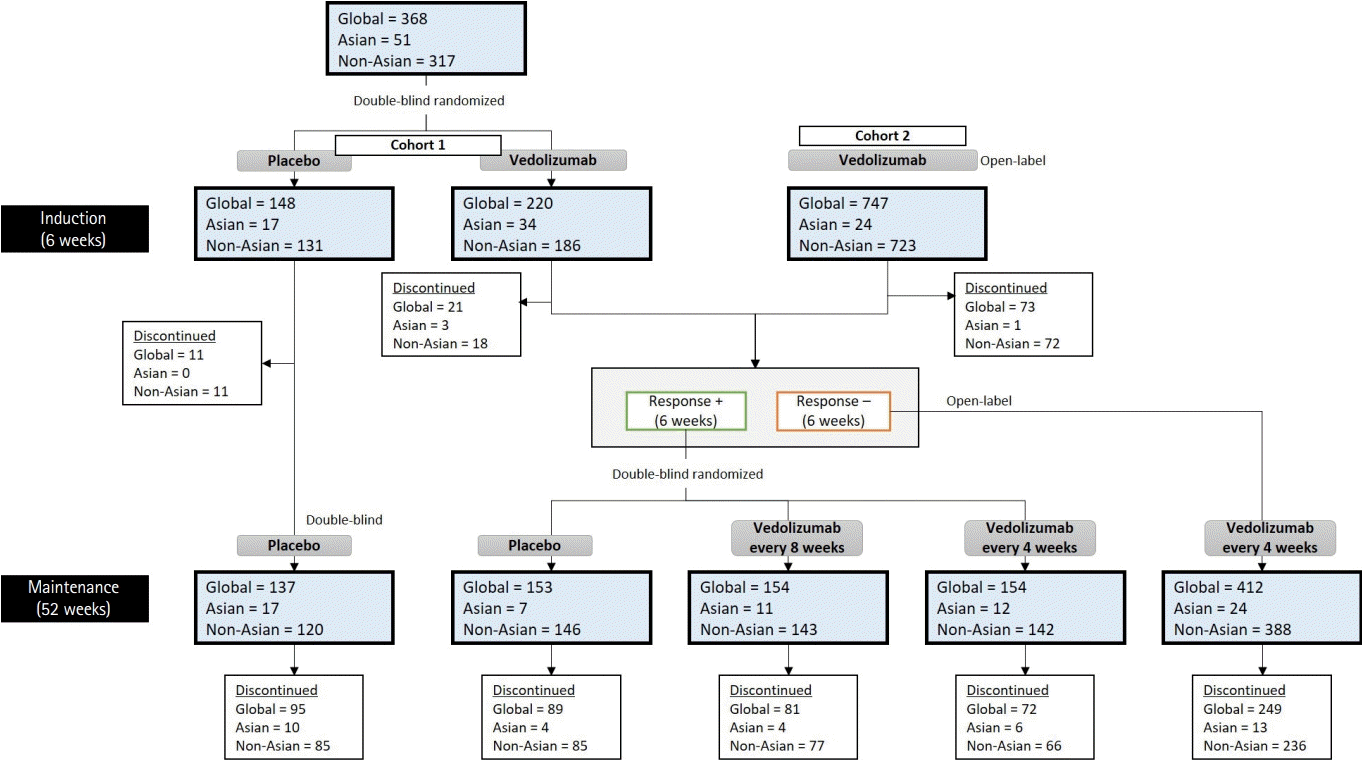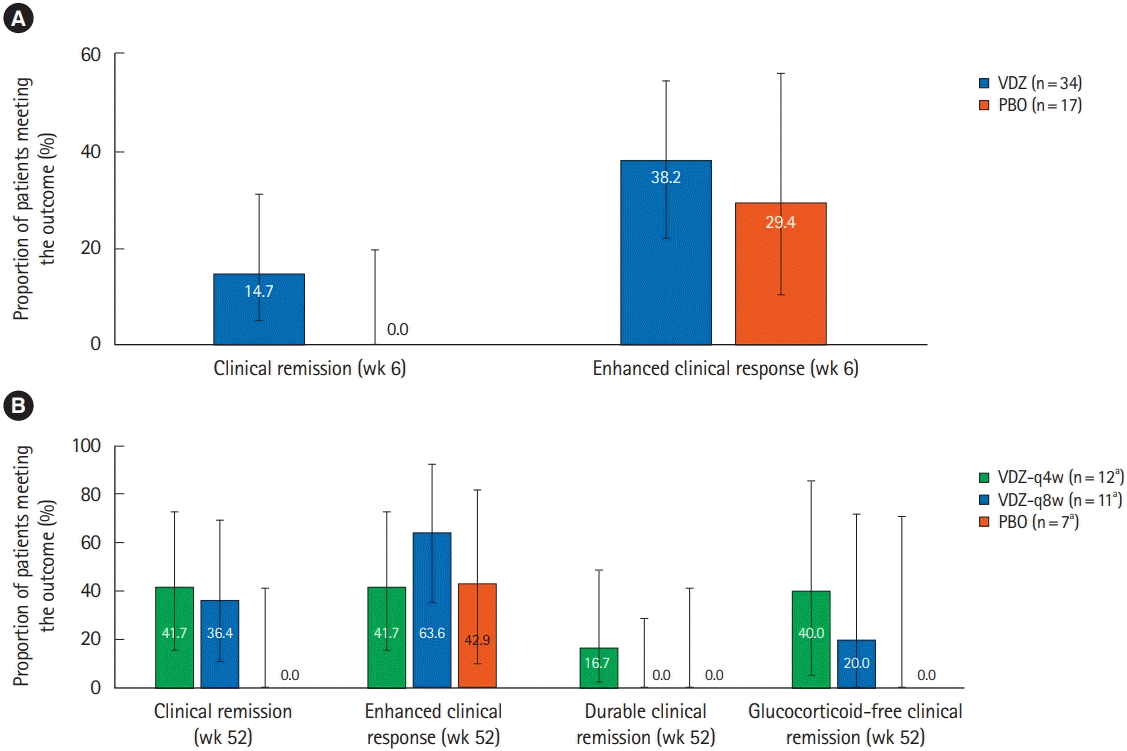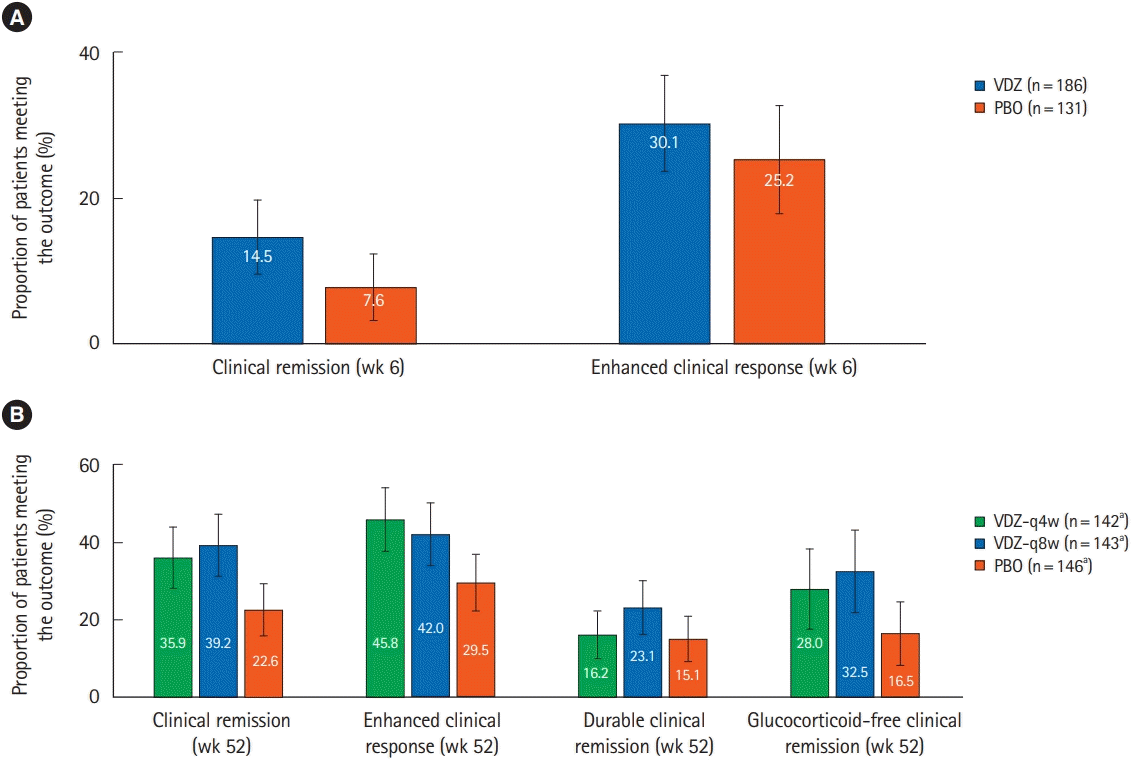Abstract
Background/Aims
Methods
Results
Notes
Conflict of Interest
Clinical trials were sponsored and conducted by Takeda Pharmaceuticals Company Ltd. Medical writing support was sponsored by Takeda Pharmaceuticals Company Ltd. Demuth D, Lindner D, and Adsul S are employees of Takeda Pharmaceuticals Company Ltd. The other authors report no conflict of interest.
Author Contribution
Conceptualization: Banerjee R, Hilmi IN, Wu DC, Demuth D, Lindner D, Adsul S. Methodology: Banerjee R, Hilmi IN, Wu DC, Demuth D, Lindner D, Adsul S. Formal analysis: Demuth D, Lindner D, Adsul S. Project administration: Banerjee R, Hilmi IN, Demuth D, Lindner D, Adsul S. Visualization: Banerjee R, Hilmi IN, Wu DC, Demuth D, Lindner D, Adsul S. Writing - original draft: Demuth D, Lindner D, Adsul S. Writing - review and editing: Banerjee R, Hilmi IN, Wu DC, Demuth D, Lindner D, Adsul S. Approval of final manuscript: all authors.
Others
The authors thank the patients and their caregivers in addition to the investigators and their teams who contributed to this study. Medical writing support was provided by Assansa, India (a Healthcare Consultancy-Assansa consultants Dr. Aamir Shaikh MD, Dr. Saifuddin Kharawala MBBS, DPM) and sponsored by Takeda Pharmaceuticals Company Ltd.
SUPPLEMENTARY MATERIALS
REFERENCES
Fig. 1.

Fig. 2.

Fig. 3.

Table 1.
Placebo and vedolizumab (cohort 1)=the groups that were part of the double-blind induction phase (induction intent-to-treat [ITT] population); Vedolizumab (cohort 2)=additional patients were enrolled to meet the maintenance phase sample size requirements and received open-label vedolizumab (induction safety population only); Vedolizumab (combined)=all patients that received vedolizumab during the induction phase.
Table 2.
| Parameter |
ITT |
Non-ITT |
Placebo combined | Vedolizumab combined | ||||
|---|---|---|---|---|---|---|---|---|
| Placebo | Vedolizumab q8w | Vedolizumab q4w | Placeboa | Vedolizumab q4wa | ||||
| No. | 7 | 11 | 12 | 17 | 28 | 24 | 51 | |
| Male sex | 3 (43) | 6 (55) | 8 (67) | 7 (41) | 19 (68) | 10 (42) | 33 (65) | |
| Age (yr) | 34.5 ± 4.7 | 38.8 ± 13.2 | 27.2 ± 6.5 | 32.4 ± 8.7 | 30.0 ± 8.9 | 33.0 ± 7.7 | 31.3 ± 10.2 | |
| Body weight (kg) | 46.0 ± 11.7 | 51.2 ± 9.3 | 53.7 ± 7.6 | 53.4 ± 15.9 | 49.0 ± 10.8 | 51.2 ± 15.0 | 50.6 ± 9.8 | |
| Duration of CD (yr) | 3.1 (1.1–11.1) | 4.1 (1.1–14.0) | 4.1 (0.6–14.2) | 2.7 (0.7–9.9) | 3.4 (0.5–13.8) | 2.9 (0.7–11.1) | 3.7 (0.5–14.2) | |
| Concomitant medications for CD | ||||||||
| Only glucocorticoids | 1 (14) | 2 (18) | 2 (17) | 2 (12) | 6 (21) | 3 (13) | 10 (20) | |
| Only immunomodulators | 1 (14) | 3 (27) | 5 (42) | 2 (12) | 5 (18) | 3 (13) | 13 (25) | |
| Glucocorticoids and immunomodulators | 2 (29) | 3 (27) | 3 (25) | 6 (35) | 5 (18) | 8 (33) | 11 (22) | |
| No glucocorticoids or immunomodulators | 3 (43) | 3 (27) | 2 (17) | 7 (41) | 12 (43) | 10 (42) | 17 (33) | |
| Patients with prior anti-TNF use | 0 | 2 (18) | 2 (17) | 4 (24) | 7 (25) | 4 (17) | 11 (22) | |
| Patients with prior anti-TNF failure | 0 | 1 (9) | 1 (8) | 4 (24) | 7 (25) | 4 (17) | 9 (18) | |
| CDAI score | 329 ± 82 | 326 ± 80 | 310 ± 97 | 349 ± 82 | 347 ± 77 | 343 ± 81 | 334 ± 83 | |
Intent-to-treat (ITT)=patients who showed response to vedolizumab at 6 weeks and were randomized as part of the double-blind maintenance phase (maintenance ITT population); Non-ITT placebo=patients that were randomized to placebo during the induction phase and continued to received double-blind placebo during maintenance phase (maintenance safety population only); Non-ITT vedolizumab q4w=patients that did not show response to vedolizumab at 6 weeks and received open-label vedolizumab during the maintenance phase (maintenance safety population only); Placebo combined=all patients that received placebo during the maintenance phase; Vedolizumab combined=all patients that received vedolizumab during the maintenance phase.
Table 3.
Table 4.
Placebo and vedolizumab (cohort 1)=the groups that were part of the double-blind induction phase (induction intent-to-treat [ITT] population); Vedolizumab (cohort 2)=additional patients were enrolled to meet the maintenance phase sample size requirements and received open-label vedolizumab (induction safety population only); Vedolizumab (combined)=all patients that received vedolizumab during the induction phase.
Table 5.
| Parameter |
ITT |
Non-ITT |
Placebo combined | Vedolizumab combined | ||||
|---|---|---|---|---|---|---|---|---|
| Placebo | Vedolizumab q8w | Vedolizumab q4w | Placeboa | Vedolizumab q4wa | ||||
| No. | 146 | 143 | 142 | 131 | 478 | 277 | 763 | |
| Male sex | 69 (47) | 62 (43) | 74 (52) | 62 (47) | 210 (44) | 131 (47) | 346 (45) | |
| Age (yr) | 37.4 ± 12.2 | 34.8 ± 12.2 | 35.6 ± 12.4 | 39.4 ± 13.5 | 36.1 ± 11.8 | 38.3 ± 12.8 | 35.7 ± 12.0 | |
| Body weight (kg) | 70.1 ± 17.7 | 69.9 ± 18.4 | 73.0 ± 18.2 | 70.7 ± 18.4 | 71.4 ± 20.3 | 70.4 ± 18.0 | 71.4 ± 19.6 | |
| Duration of CD (yr) | 7.4 (0.3–43.6) | 6.5 (0.3–34.7) | 6.8 (0.2–42.5) | 6.6 (0.3–42.0) | 8.5 (0.3–42.8) | 6.9 (0.3–43.6) | 7.6 (0.2–42.8) | |
| Concomitant medications for CD | ||||||||
| Only glucocorticoids | 55 (38) | 57 (40) | 56 (39) | 43 (33) | 157 (33) | 98 (35) | 270 (35) | |
| Only immunomodulators | 22 (15) | 24 (17) | 26 (18) | 23 (18) | 70 (15) | 45 (16) | 120 (16) | |
| Glucocorticoids and immunomodulators | 24 (16) | 20 (14) | 19 (13) | 20 (15) | 87 (18) | 44 (16) | 126 (17) | |
| No glucocorticoids or immunomodulators | 45 (31) | 42 (29) | 41 (29) | 45 (34) | 164 (34) | 90 (32) | 247 (32) | |
| Patients with prior anti-TNF use | 82 (56) | 86 (60) | 81 (57) | 68 (52) | 357 (75) | 150 (54) | 524 (69) | |
| Patients with prior anti-TNF failure | 78 (53) | 81 (57) | 76 (54) | 66 (50) | 331 (69) | 144 (52) | 488 (64) | |
| CDAI score | 325 ± 65 | 326 ± 68 | 318 ± 63 | 322 ± 77 | 323 ± 69 | 323 ± 71 | 322 ± 67 | |
Intent-to-treat (ITT)=patients who showed response to vedolizumab at 6 weeks and were randomized as part of the double-blind maintenance phase (maintenance ITT population); Non-ITT placebo=patients that were randomized to placebo during the induction phase and continued to received double-blind placebo during maintenance phase (maintenance safety population only); Non-ITT vedolizumab q4w=patients that did not show response to vedolizumab at 6 weeks and received open-label vedolizumab during the maintenance phase (maintenance safety population only); Placebo combined=all patients that received placebo during the maintenance phase; Vedolizumab combined=all patients that received vedolizumab during the maintenance phase.




 PDF
PDF Citation
Citation Print
Print



 XML Download
XML Download